What Research Shows is the Best Length and Format for DevOps Content

Do you know how long your DevOps content should be to drive the best results? Do you know the best way to format your DevOps content to optimize engagement?
Let’s take a look at what research shows is the highest-performing length and format for DevOps marketing content.
What is the Best Length?

Research shows that DevOps content between 2,000 and 3,000 words is the most popular and will perform best across SEO and social media.
Social Media Analysis
I analyzed 14,394 articles about DevOps that had more than 1.7 million shares. Below you can see a chart showing the average shares by content length of articles about DevOps and on the right you can see that content about DevOps containing 2,000 to 3,000 words gets significantly more social shares.
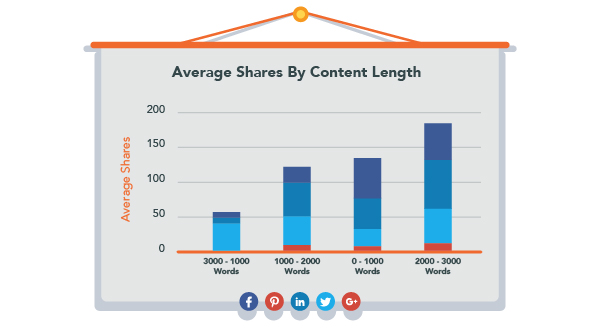
These numbers are consistent with what I find across most industries and topics. Take the BuzzFeed data collected by Buzzsumo. You might think that BuzzFeed only has short list posts, but they actually have quite a bit of long-form posts as well. BuzzSumo’s analysis found that while the majority of the content published on BuzzFeed is less than 3,000 words, the long-form content performs significantly better, with an average of 38,000 shares.
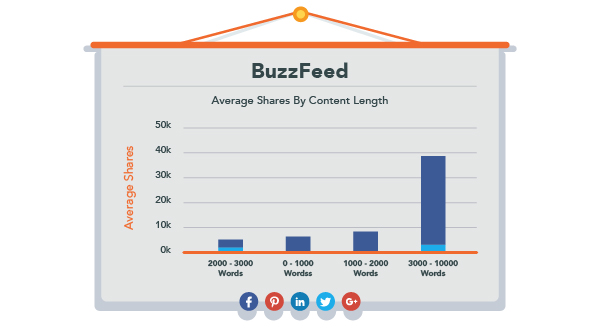
Google SEO Analysis
A recent study comparing the the top 10 search results for more than 20,000 keywords found that, on average, top articles contained more than 2,000 words. The first result for a Google search had, on average, more than 2,400 words.
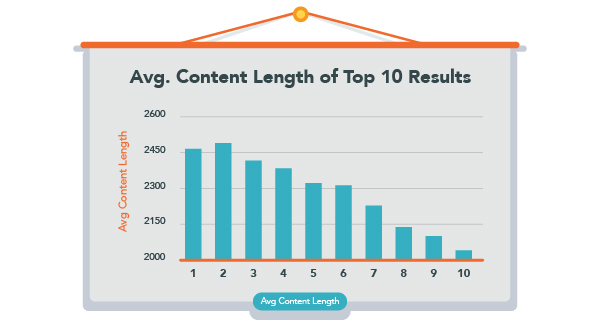
Since Google’s algorithms focus on providing searchers with the search results they would like most, this example goes to demonstrate that people prefer long content. In any case, getting your content on the first page of Google is one of the best ways to promote your content, so you should strive to do what it takes to improve your content and optimize it for Google’s algorithms, including writing long-form content.
Of course, just because people prefer long-form content doesn’t mean they want to read huge blocks of text. So, what is the best way to format all that text to increase your audience engagement?
How to Use Formatting to Increase Engagement
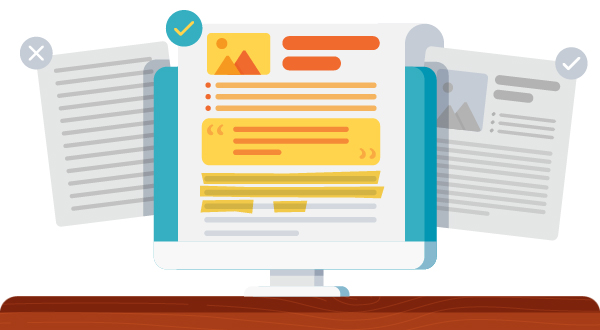
It is estimated that 79% of all people skim web content and the average visitor only reads less than 28% of the words on your site. If you want better results from your content marketing, you must format your content to engage the people who are skimming. Here’s how you can transform underperforming dull content into a super engaging lead magnet.
How to Increase Engagement with Formatting
4 formating tactics for increasing the engagement of your content:
- Increase time on page and keep readers’ attention by breaking up text every 75-100 words with images, bullet points, subheadings, and other skimmable content, and every three paragraphs.
- Engage your audience to dig deeper by telling a story through your subheadings, images, bullet points, and other skimmable content.
- Keep people to continue reading your text by treating each section as if it is the introduction to your content.
- Improve the results of your content marketing by setting aside time to optimize your content for readability.
How Often Should You Break Up Text
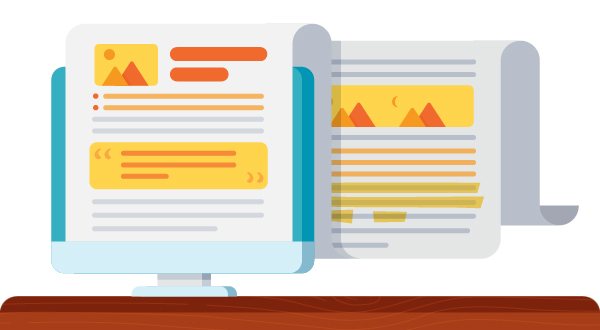
Research of 100 high-ranking blog posts found that the best posts had an image for every 350 words, while another study of 100 million articles found that you should optimally have an image for every 75-100 words.
Trying to squeeze an image every 75 words or having the resources to do so isn’t always a viable option. But, you can use other engaging content elements to break up text as well.
- Subheadings
- Bullet Points & Lists
- Block Quotes
- Highlighted Words
- Call Outs
5 Engaging Content Elements
1. Subheadings
Whether you’re writing a title or a subheading, the first few words are the most important.
“8 out of 10 people will read your headline, but only 2 out of 10 will read the rest,” says Brian Clark of Copyblogger.
Eye tracking studies from The Poynter Institute and user experience research from KISSmetrics show that people tend to scan headlines, reading the first three words of a headline first and then skipping to the last three words.
2. Stop Losing Readers — for Good — by Making Your Bullet Points & Lists Exciting
Be honest, do you really put much effort into your bullet points? Well, you should. Nielsen research found that using bullet points can increase readability 47% all on its own and when combined with other tactics can increase readability 124%.
Here are 4 ways you can transform your mediocre bullet points into attention bait:
- Prepare for skyrocketing engagement by using Questions
- Transform boring bullet points into attention grabbers with powerful Promise Statements
- Connect with your audience on a deeper level by using the word You
- If you want to be sure you will get your reader’s attention, use Numbered Lists
Bullet points are like mini-titles or sub-subheadings. You can use the same tactics for bullet points that you use for titles and subheadings. Check out these two articles to learn how to create amazing titles, first sentences, and subheadings.
3. Break Up Your Attention-Losing Wall of Text with Block Quotes
What do you do when you have a lot of text and it just doesn’t make sense to have an image, subheading, or bullet points? Use a strategic block quote to keep your audience’s attention.
“A great quotation is gold to a perceptive writer. You can instantly boost reader engagement with the right bit of wisdom or wit.”
– Brian Clark, Copyblogger
4. Keep People Reading Till the End by Using Well-Placed Highlighted Words
Highlighting key words and phrases will draw your visitors’ attention. Just be sure you don’t decrease readability too much. Using highlighted words too often can encourage those who want to read your text to start skimming unintentionally.
You can use bold font to highlight your text, but I find that becomes very distracting, so I try to use bold very sparingly. I find that hyperlinking text is a little less distracting and gives you an opportunity to link to other great content you have written.
5. Turn Your Boring Wall of Text into a Sexy Attention Magnet with Callouts
How can you make the text itself attention grabbing? Here are 4 ways you can make your text the object of everyone’s attention:
- Decrease the margins
Like a block quote, decreasing the margins tends to draw people’s eyes to your content. You can combine this tactic with others to make it even more powerful!
- Change the font color, size or style
Changing up the font is a great way to draw people’s eyes to your content. Once again, you can combine this tactic with others to make it even more powerful!
- Change the background color
Changing the background color will most certainly draw people’s eyes to your content. Once again, you can combine this tactic with others to make it even more powerful!
- Put your text inside a design element
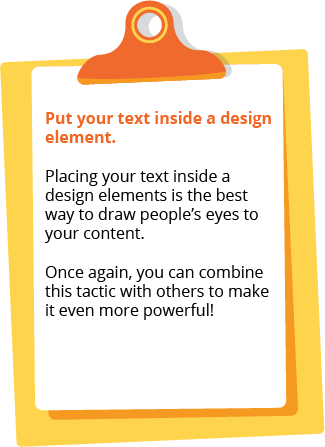
Exponentially Increase Engagement by Strategically Combining All These Tactics
Set aside dedicated time for optimizing your content’s engagement. It is easy to gloss over boring sections when you are proofing your content for the gazillionth time. Make reviewing your content’s engagement the last thing you do before going live. We’ve all seen great content get a bad title because we left the title to the last minute and just let a mediocre title go. If you want to maximize your content’s engagement, you have to plan from the beginning to have time in the end dedicated to optimizing engagement.
Review your engaging content elements and ensure they tell a story that will pull readers into your content. Your engaging content elements shouldn’t be isolated components of your content; they should work together to provide a summary of your message. Treat each section as if it were the introduction to your content.
Make sure the subheading and first few sentences:
- Pique your readers’ curiosity
- Provide proof that you are trustworthy
- Sell the benefit of reading your content
3 Scientific Reasons Why You Should Focus on Skimmers

Do you know the scientific reason people skim online?
1. We read slower online
People read online content 25% slower than printed content.
2. We have to quickly decide if content is worth our time
There is a lot of content vying for our attention. We have to quickly determine whether the content we are viewing is worth our time or we should move to the next piece of content.
Check out how much happens online in a day:
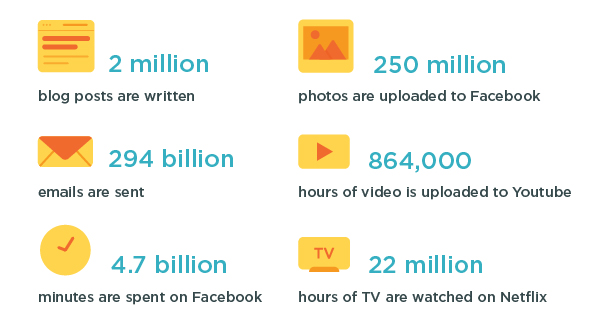
3. Our brains are being rewired for skimming
Cognitive scientists think the human brain may be changing in response to digital media. They refer to the change as the digital brain with new synapses for skimming competing with the old ones for thorough reading. Maryanne Wolf, a Tufts University cognitive neuroscientist, worries that the superficial way we read during the day is affecting us when we have to read with more in-depth processing.
Conclusion
Despite popular belief, long-form people prefer long-form content. If you want to increase the performance of your DevOps content, you should start with length and then look at how you are formatting the text.
I hope that this article inspires you to research and test what length and format drives the best results for your audience.

